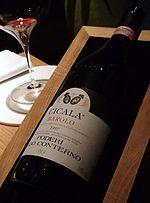Barolo, Piedmont

Barolo is a comune (municipality) in the Province of Cuneo in the Italian region Piedmont, located about 50 kilometres (31 mi) southeast of Turin and about 40 kilometres (25 mi) northeast of Cuneo. As of 30 April 2009 it had a population of 750 and an area of 5.6 square kilometres (2.2 sq mi).Barolo borders the following municipalities: Castiglione Falletto, La Morra, Monforte d'Alba, Narzole, and Novello. Barolo is an important wine-producing area noted for its Barolo wine of the same name, and many wineries such as Poderi Colla have vineyards here. Barolo is home to the multi colored art project The Chapel of Barolo by American artist Sol LeWitt and English artist David Tremlett created in 1999. It is a member of the I Borghi più belli d'Italia ("The most beautiful villages of Italy") association.
Excerpt from the Wikipedia article Barolo, Piedmont (License: CC BY-SA 3.0, Authors, Images).Barolo, Piedmont
Via San Pietro,
Geographical coordinates (GPS) Address Nearby Places Show on map
Geographical coordinates (GPS)
| Latitude | Longitude |
|---|---|
| N 44.616666666667 ° | E 7.9333333333333 ° |
Address
Via San Pietro
Via San Pietro
12064
Piedmont, Italy
Open on Google Maps







